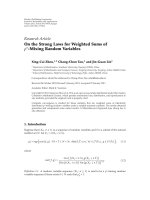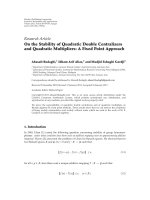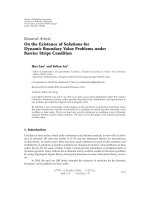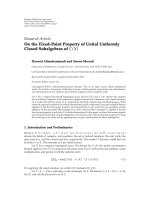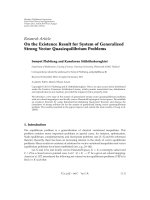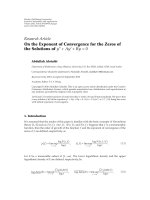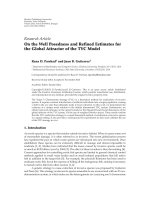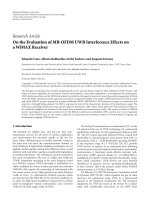Báo cáo hóa học: " Research Article On the Monotonicity and Log-Convexity of a Four-Parameter Homogeneous Mean" potx
Bạn đang xem bản rút gọn của tài liệu. Xem và tải ngay bản đầy đủ của tài liệu tại đây (508.54 KB, 12 trang )
Hindawi Publishing Corporation
Journal of Inequalities and Applications
Volume 2008, Article ID 149286, 12 pages
doi:10.1155/2008/149286
Research Article
On the Monotonicity and Log-Convexity of
a Four-Parameter Homogeneous Mean
Zhen-Hang Yang
Electric Grid Planning and Research Center, Zhejiang Electric Power Test and Research Institute,
Hangzhou 310014, China
Correspondence should be addressed to Zhen-Hang Yang,
Received 13 April 2008; Accepted 29 July 2008
Recommended by Sever Dragomir
A four-parameter homogeneous mean Fp, q; r, s; a, b is defined by another approach. The
criterion of its monotonicity and logarithmically convexity is presented, and three refined chains
of inequalities for two-parameter mean values are deduced which contain many new and classical
inequalities for means.
Copyright q 2008 Zhen-Hang Yang. This is an open access article distributed under the Creative
Commons Attribution License, which permits unrestricted use, distribution, and reproduction in
any medium, provided the original work is properly cited.
1. Introduction
The so-called two-parameter mean or extended mean between two unequal positive numbers
x and y was defined first by Stolarsky 1 as
Er, s; x, y
⎧
⎪
⎪
⎪
⎪
⎪
⎪
⎪
⎪
⎪
⎪
⎪
⎪
⎪
⎪
⎪
⎪
⎪
⎪
⎪
⎪
⎪
⎪
⎪
⎪
⎨
⎪
⎪
⎪
⎪
⎪
⎪
⎪
⎪
⎪
⎪
⎪
⎪
⎪
⎪
⎪
⎪
⎪
⎪
⎪
⎪
⎪
⎪
⎪
⎪
⎩
s
x
r
− y
r
r
x
s
− y
s
1/r−s
,r
/
s, rs
/
0,
x
r
− y
r
rln x − ln y
1/r
,r
/
0,s 0,
x
s
− y
s
sln x − ln y
1/s
,r 0,s
/
0,
exp
x
r
ln x − y
r
ln y
x
r
− y
r
−
1
r
,r s
/
0,
√
xy, r s 0.
1.1
2 Journal of Inequalities and Applications
It contains many mean values, for instance,
E1, 0; x,yLx, y
⎧
⎨
⎩
x − y
ln x − ln y
,x
/
y,
x, x y;
1.2
E1, 1; x,yIx, y
⎧
⎪
⎨
⎪
⎩
e
−1
x
x
y
y
1/x−y
,x
/
y,
x, x y;
1.3
E2, 1; x,yAx, y
x y
2
;
1.4
E
3
2
,
1
2
; x, y
hx, y
x
√
xy y
3
.
1.5
The monotonicity of Er, s; x, y has been researched by Stolarsky 1, Leach and
Sholander 2, and others also in 3–5 using different ideas and simpler methods.
Qi studied the log-convexity of the extended mean with respect to parameters in 6,
and pointed out that the two-parameter mean is a log-concave function with respect to either
parameter r or s on interval 0, ∞ and is a log-convex function on interval −∞, 0.
In 7, Witkowski considered more general means defined by
Ru, v; r, s; x, y
E
u, v; x
r
,y
r
E
u, v; x
s
,y
s
1/r−s
1.6
further and investigated the monotonicity of R.
Denote R
:0, ∞ and let fx, y be defined on Ω. If for arbitrary t ∈ R
with
tx, ty ∈ Ω, the following equation:
ftx, tyt
n
fx, y 1.7
is always true, then the function fx, y is called an n-order homogeneous functions. It
has many well properties 8–10 . Based on the conception and properties of homogeneous
function, the extended mean was generalized to two-parameter homogeneous functions in
9, which is defined as follows.
Definition 1.1. Assume f : U R
× R
→ R
is an n-order homogeneous function for
variables x and y, continuous and first partial derivatives exist, a, b ∈ R
× R
with a
/
b,
p, q ∈ R × R.
If 1, 1
/
∈U, then define that
H
f
p, q; a, b
f
a
p
,b
p
f
a
q
,b
q
1/p−q
p
/
q, pq
/
0,
H
f
p, p; a, blim
q→p
H
f
a, b; p,qG
f,p
p q
/
0,
1.8
where
G
f,p
G
1/p
f
a
p
,b
p
,G
f
x, y exp
xf
x
x, y ln x yf
y
x, y ln y
fx, y
, 1.9
f
x
x, y and f
y
x, y denote partial derivatives with respect to first and second variable of
fx, y , respectively.
Zhen-Hang Yang 3
If 1, 1 ∈ U, then define further
H
f
p, 0; a, b
f
a
p
,b
p
f1, 1
1/p
p
/
0,q 0,
H
f
0,q; a, b
f
a
q
,b
q
f1, 1
1/q
p 0,q
/
0,
H
f
0, 0; a, blim
p→0
H
f
a, b; p,0a
f
x
1,1/f1,1
b
f
y
1,1/f1,1
p q 0.
1.10
Let fx, yLx, y . We can get two-parameter logarithmic mean, which is just
extended mean Ep, q; a, b defined by 1.1. In what follows we adopt our notations and
denote by H
L
p, q; a, b or H
L
p, q or H
L
.
Concerning the monotonicity and log-convexity of the two-parameter homogeneous
functions, there are the following results.
Theorem 1.2 see 9. Let fx, y be a positive n-order homogenous function defined on U
R
× R
and be second differentiable. If I ln f
xy
< >0,thenH
f
p, q is strictly increasing
(decreasing) in either p or q on −∞, 0 and 0, ∞.
Theorem 1.3 see 10. Let fx, y be a positive n-order homogenous function defined on U
R
× R
and be third-order differentiable. If
J x − yxI
x
< >0, where I ln f
xy
, 1.11
then H
f
p, q is strictly log-convex (log-concave) with respect to either p or q on 0, ∞ and log-
concave (log-convex) on −∞, 0.
By the above theorems we have the following.
Corollary 1.4 see 10. The conditions are the same as Theorem 1.3.If 1.11 holds, then H
f
p, 1−
p is strictly decreasing (increasing) in p on 0, 1/2 and increasing (decreasing) on 1/2, 1.
If fx, y is symmetric with respect to x and y further, then the above monotone interval
can be extended from 0, 1/2 to −∞, 0 and 0, 1/2, and from 1/2, 1 to 1/2, 1 and 1, ∞,
respectively.
Corollary 1.5 see 10. The conditions are the same as Theorem 1.3.If1.11 holds, then for p, q ∈
0,
∞ with p
/
q, the following inequalities:
G
f, pq/2
< >H
f
p, q < >
G
f,p
G
f,q
. 1.12
hold. For p, q ∈ −∞, 0 with p
/
q, inequalities 1.12 are reversed.
If fx, y is defined on R
× R
and symmetric with respect to x and y further, then
substituting p q>0 for p, q ∈ 0, ∞ and p q<0 for p, q ∈ −∞, 0, 1.12 are also true,
respectively.
Let fx, yLx, y , Ax, y , Ix, y ,andD x, y in Theorems 1.2 and 1.3,
Corollaries 1.4 and 1.5, we can deduce some useful conclusions see 9, 10. These show
the monotonicity and log-convexity of Lx, y , Ax, y, Ix, y ,andDx, y depend on the
4 Journal of Inequalities and Applications
signs of I ln f
xy
and J x−yxI
x
, respectively. Noting H
L
r, s; x, y contains Lx, y,
Ax, y ,andIx, y, naturally, we could make conjecture on the similar conclusion is also true
for H
f
p, q; a, b, where fx, y H
L
r, s; x, y. Namely, the monotonicity and log-convexity
of the f unction H
H
L
also depend on the signs of I ln f
xy
< 0andJ x − yxI
x
> 0,
respectively, which is just purpose of this paper.
2. Definition and main results
For stating the main results of this paper, let us introduce first the four-parameter mean as
follows.
Definition 2.1. Assume a, b ∈ R
×R
with a
/
b, p, q, r, s ∈ R×R, then the four-parameter
homogeneous mean denoted by Fp, q; r, s; a, b is defined as follows:
Fp, q; r, s; a, b
L
a
pr
,b
pr
L
a
ps
,b
ps
L
a
qs
,b
qs
L
a
qr
,b
qr
1/p−qr−s
, if pqrsp − qr − s
/
0, 2.1
or
Fp, q; r, s; a, b
a
pr
− b
pr
a
ps
− b
ps
a
qs
− b
qs
a
qr
− b
qr
1/p−qr−s
, if pqrsp − qr − s
/
0; 2.2
if pqrsp −qr −s0, then the Fp, q; r, s; a, b are defined as their corresponding limits, for
example,
Fp, p; r, s; a, blim
q→p
Fp, q; r, s; a, b
I
a
pr
,b
pr
I
a
ps
,b
ps
1/pr−s
, if prsr −s
/
0,p q;
Fp, 0; r, s; a, blim
q→0
Fp, q; r, s; a, b
L
a
pr
,b
pr
L
a
ps
,b
ps
1/pr−s
, if prsr −s
/
0,q 0;
F0, 0; r, s; a, blim
p→0
Fp, 0; r, s; a, bGa, b, if rsr − s
/
0,p q 0,
2.3
where Lx, y,Ix, y are defined by 1.2, 1.3 respectively, Ga, b
√
ab.
It is easy to verify that Fp, q; r, s; a, b are symmetric with respect to a and b, p and
q, r and s, p, q and r, s, and then Fp, q; r, s; a, b is also denoted by Fp, q or Fr, s or
Fp, q; r, s or Fa, b.
The four-parameter homogeneous mean Fp, q; r, s; a, b contains many two-parameter
means mentioned in 9, for example, see Table 1.
In Table 1, F2, 1; r, s; a, b is just the Gini mean is also called two-parameter arithmetic
mean,
F1, 0; r, s; a, b is just the two-parameter mean or extended mean or Stolarsky mean
is also called two-parameter logarithmic mean, F1, 1; r, s; a, b is just the two-parameter
exponential mean, and F3/2, 1/2; r, s; a, b is just the two-parameter Heron mean.
Our main results can be stated as follows.
Theorem 2.2. If r s> <0,thenFp, q; r, s; a, b are strictly increasing (decreasing) in either p or
q on −∞, ∞.
Zhen-Hang Yang 5
Tabl e 1: Some familiar two-parameter mean values.
p, q Fp, q; r, s; a, bp, q Fp, q; r, s; a, b
2, 1
a
r
b
r
a
s
b
s
1/r−s
1
2
,
1
2
I
a
r/2
,b
r/2
I
a
s/2
,b
s/2
2/r−s
1, 1
I
a
r
,b
r
I
a
s
,b
s
1/r−s
2
3
,
1
3
a
r/3
b
r/3
a
s/3
b
s/3
3/r−s
1,
1
2
a
r/2
b
r/2
a
s/2
b
s/2
2/r−s
3
4
,
1
4
a
r/2
√
ab
r/2
b
r/2
a
s/2
√
ab
s/2
b
s/2
2/r−s
1, 0
s
r
a
r
− b
r
a
s
− b
s
1/r−s
4
3
, −
1
3
a
r/3
b
r/3
a
s/3
b
s/3
a
2r/3
b
2r/3
a
2s/3
b
2s/3
3/5r−s
G
2/5
1, −
1
2
a
r/2
b
r/2
a
s/2
b
s/2
2/3r−s
G
2/3
3
2
, −
1
2
a
r
√
ab
r
b
r
a
s
√
ab
s
b
s
1/2r−s
√
ab
1/2
3
2
,
1
2
a
r
√
ab
r
b
r
a
s
√
ab
s
b
s
1/r−s
2, −1
a
r
b
r
a
s
b
s
1/3r−s
√
ab
2/3
Theorem 2.3. If r s> <0,thenFp, q; r, s; a, b are strictly log-concave (log-convex) in either p
or q on 0, ∞ and log-convex (log-concave) on −∞, 0.
By Corollary 1.4,wegetCorollary 2.4.
Corollary 2.4. If r s> <0,thenFp, 1 − p; r, s; a, b are strictly increasing (decreasing) in p on
−∞, 1/2 and decreasing (increasing) on 1/2, ∞.
Notice for fx, y H
L
r, s; x, y,
G
f
x, y exp
xf
x
x, y ln x yf
y
x, y ln y
fx, y
exp
1
r − s
rx
r
x
r
− y
r
−
sx
s
x
s
− y
s
ln x
1
r − s
−
ry
r
x
r
− y
r
sy
s
x
s
− y
s
ln y
exp
1/r−s
x
r
x
r
− y
r
ln x
r
−
y
r
x
r
− y
r
ln y
r
−
x
s
x
s
− y
s
ln x
s
−
y
s
x
s
− y
s
ln y
s
I
x
r
,y
r
I
x
s
,y
s
1/r−s
,
2.4
by Corollary 1.5,wegetCorollary 2.5.
6 Journal of Inequalities and Applications
Corollary 2.5. Let p
/
q.Ifp qr s < 0,then
G
H
L
, pq/2
< Fp, q; r, s; a, b <
G
H
L
,p
G
H
L
,q
, 2.5
where G
H
L
,t
G
1/t
H
L
a
t
,b
t
,G
H
L
x, y Ix
r
,y
r
/Ix
s
,y
s
1/r−s
, Ix, y is defined by 1.3.
Inequalities 2.5 are reversed if p qr s > 0.
3. Lemmas
To prove our main results, we need the following three lemmas.
Lemma 3.1. Suppose x, y > 0 with x
/
y, define
Ut :
⎧
⎪
⎨
⎪
⎩
x
t
y
t
x
t
− y
t
tx − y
−2
,t
/
0,
L
2
x, y ,t 0,
3.1
then one has
1 U−tUt;
2 Ut is strictly increasing in −∞, 0 and decreasing in 0, ∞.
Proof. 1 A simple computation results in part 1 of the lemma, of which details are omitted.
2 By directly calculations, we get
U
t
Ut
ln x ln y −
2
x
t
ln x − y
t
ln y
x
t
− y
t
2
t
2
t
ln
x
t
y
t
−
x
t
ln x − y
t
ln y
x
t
− y
t
− 1
2
t
ln G
x
t
,y
t
− ln I
x
t
,y
t
.
3.2
By the well-known inequality Ia, b >
√
ab, we can get part two of the lemma immediately.
The following lemma is a well-known inequality proved by Carlson see 11, which
will be used in proof of Lemma 3.3.
Lemma 3.2. For positive numbers a and b with a
/
b, the following inequality holds:
La, b <
A 2G
3
a 4
√
ab b
6
. 3.3
Lemma 3.3. Suppose x, y > 0 with x
/
y, define
V t :
⎧
⎪
⎨
⎪
⎩
x
t
y
t
x
t
y
t
2
x
t
− y
t
tx − y
−3
,t
/
0;
L
3
x, y ,t 0,
3.4
Zhen-Hang Yang 7
then one has
1 V −tV t;
2 V t is strictly increasing in −∞, 0 and decreasing in 0, ∞.
Proof. 1 A simple computation results in part one, of which details are omitted.
2 By direct calculations, we get
V
t
V t
ln x ln y
x
t
ln x y
t
ln y
x
t
y
t
−
3
x
t
ln x − y
t
ln y
x
t
− y
t
3
t
1
x
t
x
t
y
t
−
3x
t
x
t
− y
t
ln x
1
y
t
x
t
y
t
3y
t
x
t
− y
t
ln y
3
t
−
x
2t
4x
t
y
t
y
2t
x
2t
− y
2t
ln x
x
2t
4x
t
y
t
y
2t
x
2t
− y
2t
ln y
3
t
3
t
−
x
2t
4x
t
y
t
y
2t
x
2t
− y
2t
ln x − ln y
3
t
2tln x − ln y
x
2t
− y
2t
x
2t
− y
2t
2tln x − ln y
−
x
2t
4x
t
y
t
y
2t
6
.
3.5
Substituting a, b for x
2t
,y
2t
in the above last one expression, then
V
t
V t
3
t
L
−1
a, b
La, b −
a 4
√
ab b
6
, 3.6
in which La, b − a 4
√
ab b/6 < 0byLemma 3.2,andL
−1
a, b > 0. Consequently,
V
t > 0ift<0andV
t < 0ift>0.
The proof is completed.
4. Proofs of main results
To prove our main results, it is enough to make certain the signs of I ln H
L
xy
and J x−
yxI
x
because Fa, b; p, q; r,sH
H
L
a, b; p,q, where H
L
H
L
r, s; x, yEr, s; x,y is
defined by 1.1.
Proof of Theorem 2.2. Let us observe that
ln H
L
1
r − s
ln |s| ln
x
r
− y
r
− ln |r|−ln
x
s
− y
s
. 4.1
Through straightforward computations, we have
I
ln H
L
xy
1
xyr − s
r
2
x
r
y
r
x
r
− y
r
2
−
s
2
x
s
y
s
x
s
− y
s
2
1
xyr − s
r
2
x
r
y
r
x
r
− y
r
2
−
s
2
x
s
y
s
x
s
− y
s
2
1
xyx − y
2
Ur − Us
r − s
.
4.2
8 Journal of Inequalities and Applications
By Lemma 3.1,
Ur − Us
r − s
U
|r|
− U
|s|
|r|−|s|
r s
|r| |s|
, 4.3
which shows that I < 0ifr s>0andI > 0ifr s<0.
By Theorem 1.2, this proof is completed.
Proof of Theorem 2.3. Let us consider that
J x − yxI
x
x − y
xyr − s
−
r
3
x
r
y
r
x
r
y
r
x
r
− y
r
3
s
3
x
s
y
s
x
s
y
s
x
s
− y
s
3
−2
xyx − y
2
V r − V s
r − s
.
4.4
By Lemma 3.3,
V r − V s
r − s
V
|r|
− V
|s|
|r|−|s|
r s
|r| |s|
, 4.5
it follows that J > 0ifr s>0andJ < 0ifr s<0.
Using Theorem 1.3, this completes the proof.
Proof of Corollary 2.4. By the proof of Theorem 2.3, there must be J < 0ifr s<0. Note
fx, y H
L
r, s; x, y is symmetric with respect to x and y, it follows from Corollary 1.4
that Fp, 1 −p; r, s; a, bH
H
L
a, b; p,1 −p is strictly decreasing in p on −∞, 0 and 0, 1/2.
Because
F0, 1; r, s; a, blim
p →0
Fp, 1 − p; r, s; a, b
L
a
r
,b
r
L
a
s
,b
s
1/r−s
s
r
a
r
− b
r
a
s
− b
s
1/r−s
,
4.6
thus Fp, 1 − p; r, s; a, b is strictly decreasing in p on −∞, 1/2.
Likewise, Fp, 1 − p; r, s; a, b is strictly increasing in p on 1/2, ∞ if r s>0.
This proof is completed.
Proof of Corollary 2.5. By the proof of Theorem 2.3, there must J < 0ifr s<0. Notice
fx, y H
L
r, s; x, y is defined on R
×R
and symmetric with respect to x and y, it follows
from Corollary 1.5 that 2.5 holds for p q>0. In this way, for r s<0andp q>0that
2.5 are also hold by Corollary 1.5. Hence, that 2.5 are always hold for p qr s < 0.
Likewise, 2.5 are reversed for p qr s > 0.
The proof ends.
Zhen-Hang Yang 9
5. Chains of inequalities for two-parameter means
Let a and b be positive numbers. The p-order power mean, Heron mean, logarithmic mean,
exponential identic mean, power-exponential mean, and exponential-geometric mean are
defined as
M
p
:
⎧
⎨
⎩
M
1/p
a
p
,b
p
if p
/
0,
Ga, b if p 0,
M A, h, L, I, Z and Y, 5.1
where L La, b,I Ia, b,A Aa, b,andh ha, b are defined by 1.2–1.5,
respectively; while the power-exponential mean and exponential-geometric mean are defined
by Z : a
a/ab
b
b/ab
and Y : E exp1 − G
2
/L
2
, in which G Ga, b
√
ab, respectively
see 9, Examples 2.2 and 2.3.
Concerning the above means there are many useful and interesting results, such as
L<A
1/3
see 12; I>A
2/3
see 13; Z ≥ A
2
see 5; h ≤ I see 14; L
2
≤ A
2/3
≤ I see
15; La, b ≤ h
p
a, b ≤ A
q
a, b hold for p ≥ 1/2,q≥ 2p/3 see 16 .
Recently, Neuman applied the comparison theorem to obtain the following result. Let
p, q, r, s, t ∈ R
. Then, the inequalities
L
p
≤ h
r
≤ A
s
≤ I
t
5.2
hold true if and only if p ≤ 2r ≤ 3s ≤ 2t see 17.
It is worth mentioning that the author obtained the following chains of inequalities
see 9, 10 by applying the monotonicity and log-convexity of two-parameter homogenous
functions:
G<L<A
1/2
<I<A, 5.3
G<I<Z
1/2
<Y<Z, 5.4
L
2
<h<A
2/3
<I<Z
1/3
<Y
1/2
. 5.5
Using our main results in this paper, the above chains of inequalities can be
generalized in form of inequalities for two-parameter means, which contain many classical
inequalities.
Example 5.1. By Theorem 2.2,forr s>0, we have
F1, −1; r, s; a, b < F
1, −
1
2
; r, s; a, b
< F1, 0; r, s; a, b
< F
1,
1
2
; r, s; a, b
< F1, 1; r, s; a, b < F1, 2; r, s; a, b,
5.6
that is,
G<
a
r/2
b
r/2
a
s/2
b
s/2
2/3r−s
G
2/3
<
s
r
a
r
− b
r
a
s
− b
s
1/r−s
<
a
r/2
b
r/2
a
s/2
b
s/2
2/r−s
<
I
a
r
,b
r
I
a
s
,b
s
1/r−s
<
a
r
b
r
a
s
b
s
1/r−s
,
5.7
10 Journal of Inequalities and Applications
which can be concisely denoted by
G<
A
a
r/2
,b
r/2
A
a
s/2
,b
s/2
2/3r−s
G
2/3
<
L
a
r
,b
r
L
a
s
,b
s
1/r−s
<
A
a
r/2
,b
r/2
A
a
s/2
,b
s/2
2/r−s
<
I
a
r
,b
r
I
a
s
,b
s
1/r−s
<
A
a
r
,b
r
A
a
s
,b
s
1/r−s
,
5.8
where L, I, A are defined by 1.2–1.4.
In particular, putting r 1,s 0; r 2s 2; r s 1in5.7, respectively, we have
the following inequalities:
G<A
1/3
1/2
G
2/3
<L<A
1/2
<I<A,
5.9
G<A
2/3
A
−1/3
1/2
G
2/3
<A<A
2
A
−1
1/2
<Z<A
2
A
−1
,
5.10
G<Z
1/3
1/2
G
2/3
<I<Z
1/2
<Y<Z,
5.11
which contain 5.3 and 5.4. Here we have used the formula Ia
2
,b
2
/Ia, bZa, bsee
9, Remark 3.
Example 5.2. By Corollary 2.4, we can get another more refined inequalities. For r s>0, we
have
F
1
2
,
1
2
; r, s; a, b
> F
2
3
,
1
3
; r, s; a, b
> F
3
4
,
1
4
; r, s; a, b
> F1, 0; r, s; a, b
> F
4
3
, −
1
3
; r, s; a, b
> F
3
2
, −
1
2
; r, s; a, b
> F2, −1; r, s; a, b,
5.12
that is,
I
a
r/2
,b
r/2
I
a
s/2
,b
s/2
2/r−s
>
a
r/3
b
r/3
a
s/3
b
s/3
3/r−s
>
a
r/2
√
a
r/2
b
r/2
b
r/2
a
s/2
√
a
s/2
b
s/2
b
s/2
2/r−s
>
s
r
a
r
− b
r
a
s
− b
s
1/r−s
>
a
r/3
b
r/3
a
s/3
b
s/3
a
2r/3
b
2r/3
a
2s/3
b
2s/3
3/5r−s
G
2/5
>
a
r
√
a
r
b
r
b
r
a
s
√
a
s
b
s
b
s
1/2r−s
√
G>
a
r
b
r
a
s
b
s
1/3r−s
G
2/3
,
5.13
which can be concisely denoted by
I
a
r/2
,b
r/2
I
a
s/2
,b
s/2
2/r−s
>
A
a
r/3
,b
r/3
A
a
s/3
,b
s/3
3/r−s
>
h
a
r/2
,b
r/2
h
a
s/2
,b
s/2
2/r−s
>
L
a
r
,b
r
L
a
s
,b
s
1/r−s
>
A
a
r/3
,b
r/3
A
a
s/3
,b
s/3
A
a
2r/3
,b
2r/3
A
a
2s/3
,b
2s/3
3/5r−s
G
2/5
>
h
a
r
,b
r
h
a
s
,b
s
1/2r−s
√
G>
A
a
r
,b
r
A
a
s
,b
s
1/3r−s
G
2/3
,
5.14
where Lx, y,Ix, y, Ax, y,andhx, y are defined by 1.2–1.5, respectively.
Zhen-Hang Yang 11
In particular, put r 1,s 0; r 2,s 1; r 1,s→ 1in5.14 and note
lim
r→s
A
a
r
,b
r
A
a
s
,b
s
1/r−s
Z
s
,
lim
r→s
h
a
r
,b
r
h
a
s
,b
s
1/r−s
I
3/2
3s/2
I
−1/2
s/2
,
5.15
we have
I
1/2
>A
1/3
>h
1/2
>L>A
1/5
1/3
A
2/5
2/3
G
2/5
>
√
hG > A
1/3
G
2/3
,
Z
1/2
>A
2
2/3
A
−1
1/3
>h
2
h
−1
1/2
>A>A
4/5
4/3
A
−1/5
1/3
G
2/5
>h
2
h
−1/2
G
1/2
>A
2/3
2
A
−1/3
G
2/3
,
Y
1/2
>Z
1/3
>I
3/2
3/4
I
−1/2
1/4
>I>Z
1/5
1/3
Z
2/5
2/3
G
2/5
>I
3/4
3/2
I
−1/4
1/2
G
1/2
>Z
1/3
G
2/3
,
5.16
respectively. Here we have again used the formula Ia
2
,b
2
/Ia, bZa, b. This shows the
inequalities 5.14 contain 5.11–5.13 in 10 and 5.5.
Example 5.3. Putting r 1,s 0; r 2,s 1; r 1,s → 1inCorollary 2.5, we have the
following inequalities:
I
pq/2
>
q
p
a
p
− b
p
a
q
− b
q
1/p−q
>
I
p
I
q
,
Z
pq/2
>
a
p
b
p
a
q
b
q
1/p−q
>
Z
p
Z
q
,
Y
pq/2
>
I
a
p
,b
p
I
a
q
,b
q
1/p−q
>
Y
p
Y
q
,
5.17
for p q>0withp
/
q.
On the other hand, putting p 1,q 0; p 2,q 1; p 3/2,q 1/2inCorollary 2.5,
we can get another inequalities
I
a
r/2
,b
r/2
I
a
s/2
,b
s/2
2/r−s
>
s
r
a
r
− b
r
a
s
− b
s
1/r−s
>
I
a
r
,b
r
I
a
s
,b
s
1/2r−s
G
1/2
,
I
a
3r/2
,b
3r/2
I
a
3s/2
,b
3s/2
2/3r−s
>
a
r
b
r
a
s
b
s
1/r−s
>
I
a
2r
,b
2r
I
a
2s
,b2
s
1/4r−s
I
a
r
,b
r
I
a
s
,b2
s
1/2r−s
,
I
a
r
,b
r
I
a
s
,b2
s
1/r−s
>
a
r
√
a
r
b
r
b
r
a
s
√
a
s
b
s
b
s
1/r−s
>
I
a
3r/2
,b
3r/2
I
a
3s/2
,b
3s/2
1/3r−s
I
a
r/2
,b
r/2
I
a
s/2
,b
s/2
1/r−s
5.18
for r s>0.
12 Journal of Inequalities and Applications
References
1 K. B. Stolarsky, “Generalizations of the logarithmic mean,” Mathematics Magazine, vol. 48, pp. 87–92,
1975.
2 E. B. Leach and M. C. Sholander, “Extended mean values,” The American Mathematical Monthly, vol.
85, no. 2, pp. 84–90, 1978.
3 B N. Guo, S. Q. Zhang, and F. Qi, “Elementary proofs of monotonicity for extended mean values of
some functions with two parameters,” Mathematics in Practice and Theory, vol. 29, no. 2, pp. 169–174,
1999 Chinese.
4 E. B. Leach and M. C. Sholander, “Extended mean values. II,” Journal of Mathematical Analysis and
Applications, vol. 92, no. 1, pp. 207–223, 1983.
5 Zs. P
´
ales, “Inequalities for differences of powers,” Journal of Mathematical Analysis and Applications,
vol. 131, no. 1, pp. 271–281, 1988.
6 F. Qi, “Logarithmic convexity of extended mean values,” Proceedings of the American Mathematical
Society, vol. 130, no. 6, pp. 1787–1796, 2002.
7 A. Witkowski, “Comparison theorem for two-parameter means,” to appear in Mathematical Inequalities
& Applications.
8 Zh H. Yang, “Simple discriminances of convexity of homogeneous functions and applications,”
Study in College Mathematics, vol. 7, no. 4, pp. 14–19, 2004 Chinese.
9 Zh H. Yang, “On the homogeneous functions with two parameters and its monotonicity,” Journal of
Inequalities in Pure and Applied Mathematics, vol. 6, no. 4, article 101, pp. 1–11, 2005.
10 Zh H. Yang, “On the log-convexity of two-parameter homogeneous functions,” Mathematical
Inequalities & Applications, vol. 10, no. 3, pp. 499–516, 2007.
11 B. C. Carlson, “The logarithmic mean,” The American Mathematical Monthly, vol. 79, no. 6, pp. 615–618,
1972.
12 T P. Lin, “The power mean and the logarithmic mean,” The American Mathematical Monthly, vol. 81,
no. 8, pp. 879–883, 1974.
13 K. B. Stolarsky, “The power and generalized logarithmic means,” The American Mathematical Monthly
,
vol. 87, no. 7, pp. 545–548, 1980.
14 J. S
´
andor, “A note on some inequalities for means,” Archiv der Mathematik, vol. 56, no. 5, pp. 471–473,
1991.
15 E. Neuman and J. S
´
andor, “Inequalities involving Stolarsky and Gini means,” Mathematica Pannonica,
vol. 14, no. 1, pp. 29–44, 2003.
16 G. Jia and J. Cao, “A new upper bound of the logarithmic mean,” Journal of Inequalities in Pure and
Applied Mathematics, vol. 4, no. 4, article 80, 4 pages, 2003.
17 E. Neuman, “A generalization of an inequality of Jia and Cau,” Journal of Inequalities in Pure and Applied
Mathematics, vol. 5, no. 1, article 15, pp. 1–4, 2004.
